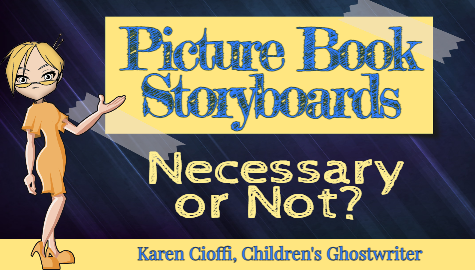When it comes to crafting a picture book, the synergy between text and illustration is crucial. Picture books are unique because they rely heavily on visual storytelling and written words. This interdependence is usually thought of as a marriage and raises an important question: Should picture book authors create storyboards for their picture book manuscripts?
Let’s dive into the role and benefits of storyboarding in the picture book creation process.
UNDERSTANDING STORYBOARDS
A storyboard is a visual representation of how a picture book story unfolds. This writing technique is also used in film, animation, and comic books. The storyboard consists of a series of drawings or images that outline each key scene or page.
A storyboard can be a series of sketches or notes that map out the flow of the narrative and how the illustrations will complement the text.
WHY STORYBOARDING CAN BE BENEFICIAL FOR THE CHILDREN'S PICTURE BOOK AUTHOR
1. Enhancing Story Flow
One of the primary benefits of storyboarding is that it helps authors visualize the narrative structure. By sketching out each page or spread, authors can better understand how the story transitions from one scene to the next.
This visual layout can reveal pacing issues, such as whether a scene is too rushed or too drawn out. Adjusting the story’s flow before it reaches the illustrator can save time and ensure a smoother reading experience.
Note: Even if your artistic ability is that of stick figures, it will be helpful.
2. Clarifying Text and Illustration Integration
In picture books, the interplay between text and illustrations is vital. Storyboarding allows authors to experiment with how text and images interact on each page.
For instance, an author might use storyboards to decide whether the text should be placed at the top or bottom of a page or if it should be placed within the illustrations.
Early planning can guide illustrators and prevent miscommunication.
Planning out the scenes is especially important when working with non-English speaking illustrators or illustrators who don’t place the text.
3. Providing a Visual Reference for Illustrators
Although illustrators often bring their own creative vision to the table, having a storyboard can provide valuable guidance.
A storyboard can act as a blueprint, giving illustrators a sense of the author’s intended visual narrative and specific details. This blueprint can be especially useful for complex scenes or when the author has a particular vision in mind that might not be immediately clear through text alone.
Note: If you’re working with a professional illustrator, give the illustrator enough room to develop his own ideas or elaborate on yours.
4. Identifying and Resolving Issues Early
Creating a storyboard allows authors to identify potential problems early in the process.
For instance, if a storyboard reveals that a crucial plot point is not adequately represented visually, the author can adjust the text or illustrations accordingly.
Having a proactive approach can help avoid costly revisions later on and streamline the overall production process, which will help save time.
5. Enhancing Collaboration
Depending on the illustrator, the author will need minor or significant collaboration. Storyboards can help by providing a tangible reference for discussions about visual elements, such as character design, scene composition, and color schemes.
By having a storyboard in hand, both parties will be on the same page. It helps alleviate confusion and will ensure that the final product aligns with the author’s vision.
When Storyboarding Might Not Be Necessary
While storyboarding offers several advantages, it may not be necessary for every picture book author. Some authors might prefer to work in a more fluid, less structured manner, allowing the illustrator more creative freedom.
In cases where the text and illustrations are highly intuitive and less dependent on detailed visual planning, a storyboard might not add significant value.
Additionally, experienced authors with a firm grasp of narrative pacing and integration might achieve similar results through text revisions and discussions with their illustrator. For these authors, storyboarding might be considered an extra step that doesn’t necessarily contribute to the creative process.
An Alternative To Storyboards
If an author is familiar with writing picture book stories, the author develops a sense of how to divide the text into pages. I usually do this with my stories. While this works with text division, it will not give you a sense of where the text should be placed on the page.
If the illustrator places the text, he'll know what to do. If the illustrator doesn't place the text, a 'good' book designer/formatter will work it out while building the book.
Summing It Up
In the picture book creation arena, storyboards offer a clear visual layout of how the story will unfold, ensuring the most effective integration of text and images. However, they are not a one-size-fits-all solution and may not be necessary for every author.
So, should you or shouldn’t you create a storyboard? Ultimately, it’s the author’s decision.

I’m a working children’s ghostwriter, rewriter, editor, and coach. I can help turn your story into a book you’ll be proud to be the author of, one that’s publishable and marketable.
OTHER HELP I OFFER:
HOW TO WRITE A CHILDREN’S FICTION BOOK
A DIY book to help you write your own children’s book.
PICTURE BOOK, CHAPTER BOOK, MIDDLE GRADE COACHING
Four to ten-week coaching programs.
WRITERS ON THE MOVE SELF-PUBLISHING HELP.
Self-publishing help for children’s authors.
Creating An Author Online Platform
Step-by-step with a former WOW! Women on Writing author online platform instructor
You can contact me at: kcioffiventrice@gmail.com. Or give me a call at 347—834—6700. (Please leave a message- I’ll get back to you as soon as I can.)

So, What Can Go Wrong With Children’s Books Illustrations?
The Making of a Children’s Book Illustrations
Picture Books – Story or Illustrations, Which Comes First?


2 thoughts on “Should Picture Book Authors Create Storyboards?”